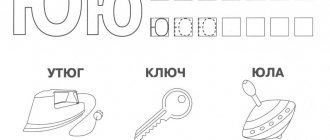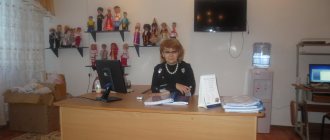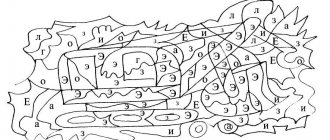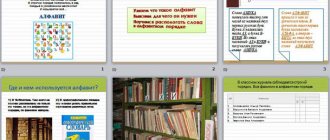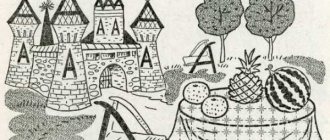Work program for teaching literacy “From birth to school”
- The sleighs are good, of course, but they are cunning: They go down the hill on their own, but pull them up the hill!..
Fairy tales
This verbal technique is great for motivating children, and also gives an idea of the language concepts that children encounter in the learning process, for example, the order of letters in a word. As an example, I will give a fairy tale about the word house: “In one bookish state there lived letters. And one day such a story happened there. The letters “D”, “O”, “M” decided to build a house out of cubes, only it kept falling down. The letter “O” kept running forward and trying to stand on the roof, offended that it was second and not first.
While telling this tale, you can show the following picture: the letter O is offended that it is not the first
The letter “M” didn’t want to be the last one at all and ran away. They looked for her for a long time in the book kingdom. When they found it, they put it at the end, the letter “D” was in front, and the letter “O” was second. Since then the house has stopped swaying and falling.”
As the story progresses, children can complete letter search tasks
When choosing or composing fairy tales on a topic, you must:
- connect illustrations to the story;
- do not overload with characters and plot twists;
- use understandable vocabulary;
- maintain timing.
Reading
A technique that is actually the result of work on a literacy course. This skill must also be developed in the process of getting to know, practicing or consolidating the material. In other words, children, having mastered the required minimum of syllabic reading, can read words themselves - captions for pictures or phrases - instructions for games at the introductory or main stages of the lesson.
Tongue Twisters
An important technique for practicing speech skills is pronouncing tongue twisters. For children of older preschool age, they can also have humorous content (the kids will definitely appreciate this):
- Yogis flew to Yoshkar-Ola and ate yogurt along the way.
- Sharp horns The goat has Earrings. And Seryozhka said: “I’m a little afraid.”
Visual techniques
The fact that all tasks should be supported by illustrations has already been mentioned above. Therefore, we will focus on such important visual techniques as demonstration and display. The first presupposes the teacher’s personal example in one activity or another. So, in order to teach children to highlight a stressed syllable in words, the teacher first pronounces the words himself with an emphasis on the desired vowel, that is, he “sings” it. And if he is practicing writing a letter, he writes it down on the board several times, commenting on the order in which the elements are performed.
The screening includes children watching presentations and videos on the topic. For example, familiarization with sounds can begin with suitable excerpts from the educational cartoon “ABC for Kids,” in which sounds are presented through fairy tales. That is, children remember educational material as the plot develops.
Practical techniques
With the help of practice, children practice and consolidate knowledge, skills and abilities. First of all, it is worth noting the children’s work in copybooks, where they trace elements along the contours, write fragments of letters and gradually come to their full writing. In addition, the fixation of letters can be in the form:
| Type of games | Name | Goals | The order of game actions |
| Educational | "Name the Sound" | Learn to recognize sound by the movement of the articulatory apparatus | The teacher shows the pronunciation of the sound, the children guess what the sound is. To make it more difficult, you can show one-syllable and two-syllable words |
| "Lay out the pictures" | Learn to differentiate sounds (by similarity in pronunciation in an unstressed position, by hardness - softness, etc.) | Children give drawings depicting an object with the letter “a” to the doll Anya, and with the letter “o” to Olya | |
| Interactive | Contribute to the development of knowledge, skills and abilities on the topic. For example, “Learning the alphabet with Luntik” | ||
| Movable | “Guess and then catch up” | Develop phonemic awareness | The driver is put on a scarf or blindfold, and a participant comes up to him and calls him by name. If the driver guessed who called him, then he removes the scarf and runs after the player. If you manage to show off, then this player becomes the driver |
| "Rolling the Ball" | Expand your vocabulary on the topic | The teacher formulates a task, for example, to name as many pleasant words about mommy as possible. Kids throw a ball into a hoop or basketball hoop, saying words | |
| Theatrical | "Finger Boy" |
| Children put on finger theater puppets and illustrate the rhyme:
|
| Role-playing games, for example, “At the Doctor’s” |
| Children act out scenes based on the theme of the lesson, using words from special vocabulary (for example, tonometer, inhalation, etc.) | |
| Finger |
|
| |
| |||
- drawings;
- applications (for example, filling the contours of letters individually or as part of a word with cereal);
- crafts (3-dimensional letters, syllables or words, for example, made from plasticine or polymer clay).
Practical techniques can be indirectly related to the educational course, for example, creating an application with elements for the letters C and V
Gaming techniques
Three types of games are used in classes to teach the basics of reading and writing:
- training (for acquaintance, development and practical application of knowledge, skills and abilities);
- mobile (carried out to satisfy children’s needs for movement, but based on a relevant topic);
- theatrical (based largely on the personal experience of the children and consist in the presentation of material in the form of theatrical performances).
Table: examples of games for teaching literacy
How to personalize tasks
Speech development is an individual process, which means that literacy learning associated with it may also not occur in the same way for different children: some are good at identifying all the sounds in a word, while others have difficulty naming the first one. In this case, the teacher must try to individualize tasks.
In my practice, I encountered a problem when several children could not determine the number of syllables in words. I offered them the following task: I gave them 3-4 cards depicting animals (for example, a wolf, a fox, a dog) and 3-4 pictures depicting buildings. One had one window, the second two, the third three. The guys had to count the windows and vowels in the words - the names of animals, match them and thus find the owners of the houses.
In addition, you can individualize work with children using:
- additional tasks for those who perform basic tasks very quickly;
- memorizing (or retelling) texts for children with a slow speech rate or a small vocabulary;
- attracting unresponsive, shy children to prepare the room for class, that is, laying out materials on tables, preparing workplaces (this makes the kids feel their importance, and therefore experience a situation of success).
Individualization certainly includes one-on-one work.
⇐ Previous2Next ⇒
Recommended pages:
